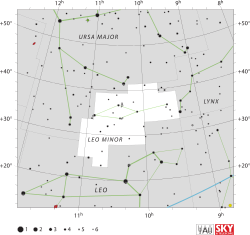Beta Leonis Minoris
Star in the constellation of Leo Minor From Wikipedia, the free encyclopedia
Beta Leonis Minoris, Latinized from β Leonis Minoris, is a binary star in the constellation of Leo Minor. It has an overall apparent visual magnitude of approximately 4.2. Although it is the only star in Leo Minor with a Bayer designation, it is only the second brightest star in the constellation (the brightest is 46 Leonis Minoris).[5]
| Observation data Epoch J2000.0 Equinox J2000.0 (ICRS) | |
|---|---|
| Constellation | Leo Minor |
| Right ascension | 10h 27m 53.000s[1] |
| Declination | +36° 42′ 25.96″[1] |
| Apparent magnitude (V) | 4.21 (4.40/6.12)[2] |
| Characteristics | |
| Evolutionary stage | red clump[3] |
| Spectral type | G9III[4] |
| U−B color index | +0.64[2] |
| B−V color index | +0.90[2] |
| R−I color index | +0.46[2] |
| A | |
| Spectral type | G8III-IV[2] |
| B | |
| Evolutionary stage | subgiant[5] |
| Spectral type | F8IV[2] |
| Astrometry | |
| Radial velocity (Rv) | 8.52[6] km/s |
| Proper motion (μ) | RA: −127.68[1] mas/yr Dec.: −110.31[1] mas/yr |
| Parallax (π) | 21.19±0.50 mas[1] |
| Distance | 154 ± 4 ly (47 ± 1 pc) |
| Absolute magnitude (MV) | +0.85[6] |
| Orbit[7] | |
| Period (P) | 13,965±40 |
| Semi-major axis (a) | 0.3782″±0.0007″ |
| Eccentricity (e) | 0.680±0.002 |
| Inclination (i) | 81.4±0.1° |
| Periastron epoch (T) | 2451411.1±4.8 JD |
| Argument of periastron (ω) (secondary) | 215.7±0.2° |
| Semi-amplitude (K1) (primary) | 7.93±0.05 km/s |
| Semi-amplitude (K2) (secondary) | 12.32±0.18 km/s |
| Details | |
| A | |
| Mass | 2.98±0.10[7] M☉ |
| Radius | 9.4±0.3[7] R☉ |
| Luminosity (bolometric) | 50.7±1.8[7] L☉ |
| Surface gravity (log g) | 2.85[6] cgs |
| Temperature | 5,299±63[7] K |
| Metallicity [Fe/H] | +0.09[6] dex |
| Rotational velocity (v sin i) | 2.54[6] km/s |
| Age | 1.2[6] Gyr |
| B | |
| Mass | 1.92±0.04[7] M☉ |
| Radius | 2.0[7] R☉ |
| Luminosity (bolometric) | 17.6[7] L☉ |
| Temperature | 5,484[7] K |
| Other designations | |
| Beta Leonis Minoris, Beta LMi, β LMi, Beta LMi, 31 Leonis Minoris, BD+37 2080, FK5 390, GC 14358, HD 90537, HIP 51233, HR 4100, SAO 62053, PPM 75233, ADS 7780, CCDM J10279+3642, WDS 10279+3642[2][8][9] | |
| Database references | |
| SIMBAD | data |
Binary system
β Leonis Minoris is a binary that can be resolved for a portion of each orbit. When the two components are too close to resolve, it appears as a single G9 giant star with some indications of a second set of spectral lines. The orbit derived as a double-lined spectroscopic binary is poor, and a better orbit has been calculated using only the spectral lines of the primary, plus input from the known visual observations. The orbital period is nearly 39 years and the eccentricity is high at 0.683. The semi-major axis of the orbit is 0.36″, but the separation varies from 0.1 to 0.6″.[10]
The primary star is a late G-class red clump giant, a star that is fusing helium in its core and lies at the cool end of the horizontal branch.[3] The properties of the secondary star can only be estimated from its relative brightness and its spectral class. It is an F8 subgiant, hotter than the sun and starting to evolve away from the main sequence.[5]
References
Wikiwand - on
Seamless Wikipedia browsing. On steroids.

